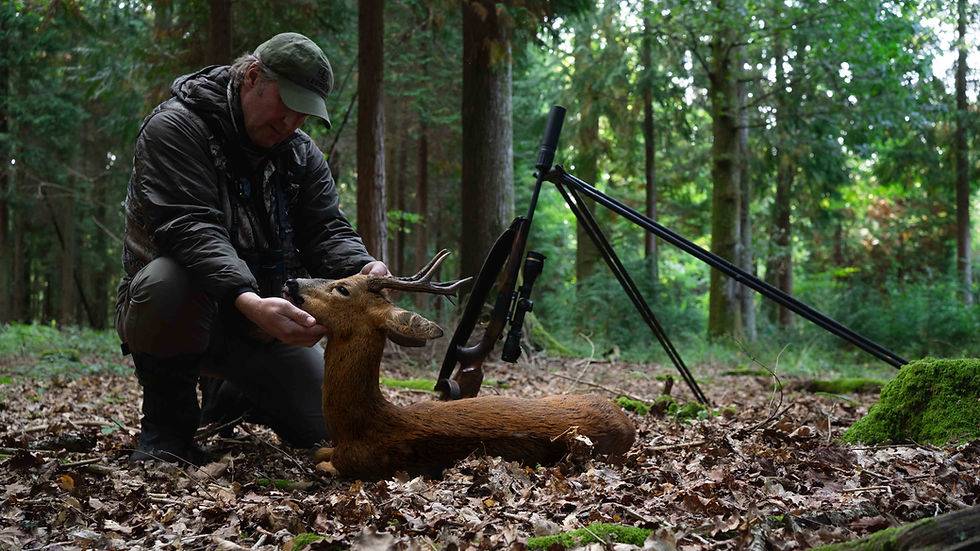Why Deer Management Must Be Central to Woodland Creation in 2025
- Owen Beardsmore

- Jan 9
- 4 min read
Updated: Jan 13
Introduction: Looking Ahead in 2025
As we step into 2025, the urgency of addressing our climate and biodiversity crises has never been clearer. Across the UK, woodland creation is at the forefront of these efforts, with ambitious goals like the Government’s plan to plant 30,000 hectares of new woodland annually.
But as we celebrate these initiatives, we must also critically examine their execution. The interplay between woodland creation and deer management presents one of the most significant challenges—and opportunities—for landowners, forestry professionals, and deer managers this year.

Over the coming months, we’ll explore a wide range of topics shaping the modern deer-stalking landscape. Such as, exploring the complexities of managing deer in areas of high public access, navigating the Countryside Stewardship schemes (WD1, WD2, WS1, and more), and lowland deer impact on agriculture.
For now, we turn to a foundational issue for the year: the role of deer management in securing the long-term success of woodland creation projects.
Deer Management: The Missing Link in Woodland Creation
The Government’s woodland targets are ambitious—and necessary: Woodland covers 13% of the UK, but ancient woodland accounts for only 2.5%—a precious and finite resource. Restoring natural landscapes and expanding tree cover are vital steps in combating climate change and bolstering biodiversity. Yet, these efforts are often undermined by a critical oversight: deer management.
Deer populations in the UK have reached historic highs. Species like roe, muntjac, and fallow deer pose a severe threat to young woodlands, causing damage through browsing, bark stripping, and fraying. Without effective management, saplings struggle to survive, biodiversity suffers, and significant investments are wasted.
At Cervus-UK, we’ve seen the consequences of neglecting deer management firsthand. Projects that fail to address deer populations during the planning stages often face setbacks that are difficult—and costly—to resolve later.
Key Solutions for Integrating Deer Management:
Public-Restricted Zones
The presence of the public in woodlands is often a barrier to effective deer management. To ensure safe and efficient culling practices, landowners should establish designated areas where public access is restricted during certain times. Clear communication and signage are crucial for maintaining safety while prioritising effective and discreet management.
Smarter Tree Protection
Tree guards are a staple of woodland creation, but they must be designed with the local deer species in mind. For sites with fallow deer, for example, 1.2m guards are insufficient. Upgrading to 1.4m guards or higher provides the necessary protection against browsing and fraying. While this increases upfront costs, it’s a vital investment for long-term success.
Thoughtful Woodland Planting Design
Woodland design should factor in deer behavior and management needs from the outset. Planting schemes can incorporate features like rides, deer lawns, and safe culling zones. These elements not only facilitate effective management but also create diverse habitats that benefit a wide range of species, including insects, butterflies and moths. In recent years, with the extremely wet winter months, carcass extraction routes should also be considered.
Learning from Experience:
Schemes such as the England Woodland Creation Offer (EWCO) are a prime example of how government-funded grants can support woodland expansion and "help to mitigate climate change, deliver nature recovery and provide wider environmental and social benefits".
However, without integrating deer management into these schemes from the start, they risk falling short of their potential.
Key to this, is an initial survey to establish the deer species that are present and those liable to be present in the first 10 years of the forest life. We have experienced on numerous occasions where foresters, unfamiliar to the area, or with no practical knowledge of deer have made assumptions of tree protection specifying the wrong size.
It is our opinion, that fenced areas within woodland to protect newly planted trees and coppice are a complete waste of time if muntjac are present. These areas can also be detrimental to deer management as they become an impenetrable thicket (sanctuary) where no practical management is possible, resulting in a population increase and thus, the opposite is achieved.

Looking Ahead in 2025:
The challenges of restoring woodland in a landscape shared with deer are significant, but they’re not insurmountable. By prioritising deer management in the early planning stages, we can maximise the ecological and economic benefits of woodland creation projects.
This year, our focus at Cervus-UK will be on sharing practical strategies and articles to help landowners, foresters and fellow deer managers navigate these challenges. From designing deer-friendly woodlands to exploring modern management solutions.
As we embark on this journey into 2025, one thing is clear: the future of our woodlands depends on our ability to balance restoration efforts with sustainable deer management at the forefront.
Conclusion: Let’s Make Deer Management a Priority
So, what’s your take? Should deer management play a bigger role in woodland creation and planting design? We believe it’s not just a necessity, but a responsibility for anyone involved in land stewardship.
If you’re ready to tackle these challenges head-on, stay tuned for more insights and practical advice throughout the year. Together, we can build a future where woodlands thrive, biodiversity flourishes, and deer are managed responsibly by competent deer managers and more informed landowners.







40 years too late Owen!!! I am referring to Scotland, there has been very poor planning for deer impacts for decades in private as well as the old Forestry Commission and now we pay the price, But it is important now to learn from that and planting schemes should not now be passed unless there is a clear deer plan for the lifetime of any proposed forest in place. The bottom line is deer management costs money and there has been an all too 'laissez faire' attitude. Good points made here. Bill
Very interesting read, thanks for taking the time to share your thoughts
Wildlife management is inextricably linked to forest management.